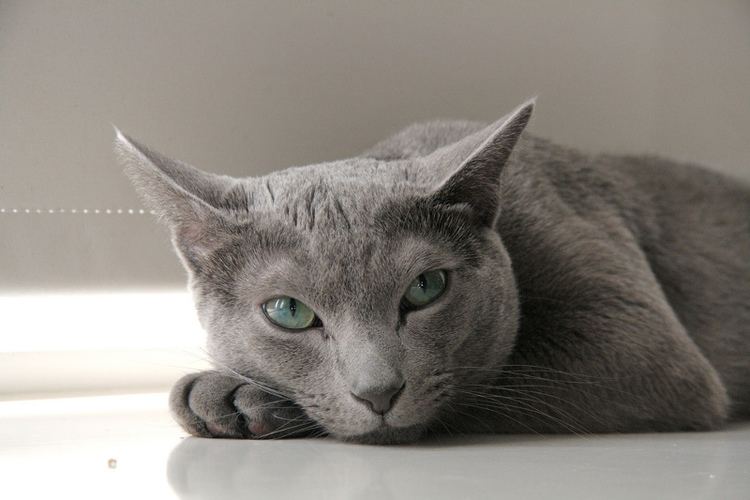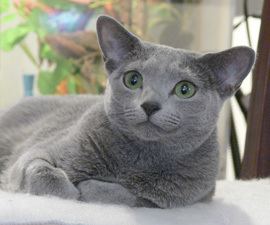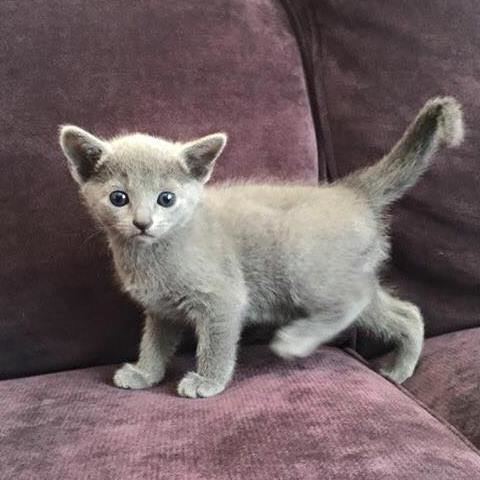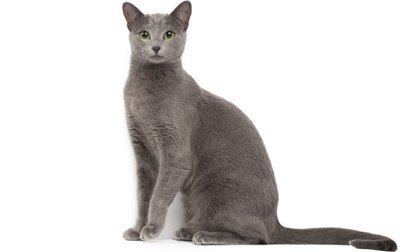CFA standard TICA standard ACF standard Rank Breed | FIFe standard AACE standard Scientific name Felis catus Higher classification Cat | |
 | ||
Other names Archangel Blue, Archangel Cat Similar British Shorthair, Birman, Scottish Fold, Abyssinian cat, Chartreux | ||
The Russian Blue is a cat breed that comes in colors varying from a light shimmering silver to a darker, slate grey. They develop close bonds with their owners and are sought out as pets due to their personalities, beauty and coat. It is their short, dense coat which has been the hallmark of the Russian breed for more than a century. The dense coat stands out from the body and you can draw patterns in the coat that will stay until you smooth them out again.
Contents
- Russian blue cat vs british shorthair differences explained
- Origin
- Physical characteristics
- Behavioral characteristics
- Growth and maturity
- Allergies
- In popular culture
- References

Russian blue cat vs british shorthair differences explained
Origin

The Russian Blue is a naturally occurring breed that may have originated in the port of Arkhangelsk, Russia. They are also sometimes called Archangel Blues. It is believed that sailors took Russian Blues from the Archangel Isles to Great Britain and Northern Europe in the 1860s. The first recorded appearance outside of Russia was in 1875 at the Crystal Palace in England, as the Archangel Cat. The Russian Blue competed in a class including all other blue cats until 1912, when it was given its own class.

The breed was developed mainly in England and Scandinavia until after World War II. Right after the war, a lack of numbers of Russian Blues led to cross breeding with the Siamese. Although Russian Blues were in America before the war, it was not until the post-war period that American breeders created the modern Russian Blue that is seen in the US today. This was done by combining the bloodlines of both the Scandinavian and British Russian Blues. The Siamese traits have now largely been bred out. The short hair and slate-gray/blue color is often seen in mixed-breed cats, which can affect breeders and showers due to mislabeling a cat as a Russian Blue.
Russian Blues are plush short-haired, shimmering pale blue-gray cats with emerald green eyes. Guard hairs are distinctly silver-tipped giving the cat a silvery sheen or lustrous appearance. They have been used on a limited basis to create other breeds (such as the Havana Brown) or alter existing breeds (such as the Nebelung). Currently they are being used in Italy as a way to make Oriental Shorthairs healthier and more robust called RUS4OSH in FIFe.
Russian Whites and Russian Blacks were created from crosses with domestic white cats which were allegedly imported from Russia. The first line was developed by Frances McLeod (Arctic) in the UK during the 1960s and the second line produced by Dick and Mavis Jones (Myemgay) in Australia in the 1970s. By the late 1970s, the Russian White and Russian Black colors were accepted by cat fanciers in Australia as well as in South Africa and now also in the United Kingdom as Russian cats (in different classes). However, the Cat Fanciers Association and FIFe does not recognize any variation of the Russian Blue.
Physical characteristics
The Russian Blue has bright green eyes, pinkish lavender or mauve paws, two layers of short thick fur, and a blue-grey coat. The color is a bluish-gray that is the dilute expression of the black gene. However, as dilute genes are recessive ("d") and each parent will have a set of two recessive genes ("dd") two non-CPC Russian Blues will always produce a blue cat. Due to the breeding with Siamese after WWII there are colorpoint genes floating around. If you breed two carriers together then you will get a litter of mixed colors – solid blue or white with blue like a Siamese. People call these CPC cats "colorpoint", "whites" or "pointed" Russians. In most registries you cannot register, breed or show a colorpoint Russian. The coat is known as a "double coat", with the undercoat being soft, downy, and equal in length to the guard hairs, which are an even blue with silver tips. The tail, however, may have a few very dull, almost unnoticeable stripes. The coat is described as thick, plush and soft to the touch. The feeling is like the softest velvet. The silver tips give the coat a shimmering appearance. Its eyes are almost always a dark and vivid green. Any white patches of fur or yellow eyes in adulthood are seen as flaws in show cats. Russian Blues should not be confused with British Blues (which are not a distinct breed, but rather a British Shorthair with a blue coat; the British Shorthair breed itself comes in a wide variety of colors and patterns), nor the Chartreux or Korat which are two other naturally occurring breeds of blue cats, although they have similar traits.
Behavioral characteristics
The Russian Blue is a curious and tranquil animal. They are known for their friendliness and intelligence, and are somewhat reserved. They have been known to play fetch, open doors, and are sensitive to human emotions. They enjoy playing with a variety of toys and develop loyal bonds to their loved ones and other family pets. They are generally considered to be a quiet breed but there are always exceptions. They are clean animals that are normally reserved around strangers, unless they are brought up in an active household. Many Russian Blues have been trained to do tricks. Russian Blues can also be fierce hunters, often catching rodents, birds, rabbits, small mammals, or reptiles.
Growth and maturity
Russian Blues have an average life expectancy of around 10–20 years, some have even lived up to a maximum of 25 years, and have few health problems as they tend to have little to no genetic problems and are not prone to illness. They are small to moderate-sized cats with an average weight of 2 to 7 kg (4.4 to 15.4 lb) when full grown. Males will typically be larger than females. Their gestation period is approximately 64 days.
Allergies
Anecdotal evidence suggests that the Russian Blue may be better tolerated by individuals with mild to moderate allergies. There is speculation that the Russian Blue produces less glycoprotein Fel d 1, one source of cat allergies. The thicker coat may also trap more of the allergens closer to the cat's skin. Glycoprotein is one source of cat allergies, but this does not mean they are suitable to be homed with people allergic to cats; they will still cause the allergy to be affected, only to a lesser degree for short periods of time.
